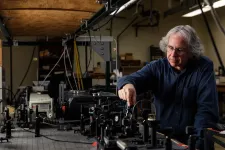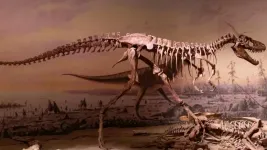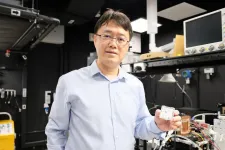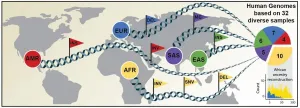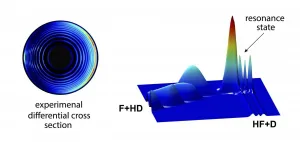(Press-News.org) ITHACA, N.Y. - A team from Cornell University's Environmental Systems Lab, led by recent graduate Allison Bernett, has put forth a new framework for injecting as much information as possible into the pre-design and early design phases of a project, potentially saving architects and design teams time and money down the road.
"(Our framework) allows designers to understand the full environmental impact of their building," said Bernett, corresponding author of "Sustainability Evaluation for Early Design (SEED) Framework for Energy Use, Embodied Carbon, Cost, and Daylighting Assessment" which published Jan. 10 in the Journal of Building Performance Simulation.
Principle investigators are Timur Dogan, assistant professor of architecture in the College of Architecture, Art and Planning; and Katharina Kral, a licensed architect and lecturer in the Department of Architecture.
"How we look at this is, there's the cost of change in the design process, and then the opportunity of impact," Dogan said. "In the very beginning, changing something doesn't cost anything, but if you're a month into the project, changing something is really expensive, because now you have to rehire consultants and redesign things.
"And then the other thing is the potential of impact," he said. "In the very beginning, just with a simple nudge in the right direction, you can change a project from being an energy hog to something that's very sustainable, and integrates well into the environment."
In 2018, according to the International Energy Agency, the construction sector accounted for 39% of energy and process-related greenhouse gas emissions. That included 11% originating from the manufacturing of building materials and products.
The Sustainability Evaluation for Early Design (SEED) Framework is a decision-making tool that can dynamically and concurrently simulate several variables: building energy performance; embodied carbon (carbon emissions generated by construction and materials); construction cost; and daylighting (the use of natural light to illuminate indoor spaces).
The framework will allow architects and design teams to rapidly trial and rank tens of thousands of design iterations, using as few as four inputs.
Using publicly available data and a suite of available design simulation programs - including Rhino/Grasshopper (a CAD program); ClimateStudio, developed by Dogan, for daylight simulation and building energy modeling; and engineering software Karamba3D - Bernett and the team tested SEED in a case study of a hypothetical mid-sized office building modeled in Boston, Washington, D.C., and Phoenix.
The SEED Framework generated thousands of design options based on variables specific to the three cities in the case study, offering designers the flexibility of many options early in the process, before changing course would get too expensive.
"The idea is, you run this analysis," Dogan said, "and you get a few options that already make a lot of sense, and some options that you can completely forget about. ... [It] always comes down to this lack of information in the decision-making process.
"In that sense, the construction industry is super inefficient," he said. "There's too many players who don't know the full picture and then make decisions that are not always rational. This framework that Allison worked on is geared to help bring the information to the table. Every stakeholder in the design process can then form their own opinion about design goal priorities."
SEED's greatest asset, Bernett said, is amassing a tranche of data on multiple factors in one place, and involving architects early in the design and pre-design phases.
"It takes a lot of time to gather all that data, and we have that prepackaged. So there's definitely a hunger for that," said Bernett, who presented the SEED Framework in September 2019 at the International Building Performance Simulation Conference, in Rome.
"Right now, we rely heavily on energy modelers and consultants to do this work," she said. "And if we can involve architects more readily and more early on, I think that we're going to see a lot of improvement and cost-effectiveness to these early design decisions."
In addition to the publicly available design simulations, the team used AutoFrame, a new procedure developed by Kral for automatically computing structural systems. AutoFrame helps improve the precision of embodied carbon assessments and daylight simulations.
The Cornell Atkinson Center for Sustainability's Small Grants Program provided pivotal support for this work, Bernett said.
"That funding really gave it the push it needed," she said. "It allowed me to present a first iteration [of SEED] at the conference in Rome, and then to really flesh out the research more after that."
INFORMATION:
WEST LAFAYETTE, Ind. -- Doppler radar improves lives by peeking inside air masses to predict the weather. A Purdue University team is using similar technology to look inside living cells, introducing a method to detect pathogens and treat infections in ways that scientists never have before.
In a new study, the team used Doppler to sneak a peek inside cells and track their metabolic activity in real time, without having to wait for cultures to grow. Using this ability, the researchers can test microbes found in food, water, and other environments to see if they are pathogens, or help them identify the right medicine to treat antibiotic-resistant bacteria.
David Nolte, Purdue's Edward ...
HOUSTON - (Feb. 25, 2021) - Low-income livestock farmers in developing countries are often faced with a difficult dilemma: protect their animals from endangered predators, or spare the threatened species at the expense of their livestock and livelihood.
A new paper by Rice University economist Ted Loch-Temzelides examines such circumstances faced by farmers in Pakistan. "Conservation, risk aversion, and livestock insurance: The case of the snow leopard" outlines a plan under which farmers can protect themselves from crippling financial losses while ...
While the amazing regenerative power of the liver has been known since ancient times, the cells responsible for maintaining and replenishing the liver have remained a mystery. Now, research from the Children's Medical Center Research Institute at UT Southwestern (CRI) has identified the cells responsible for liver maintenance and regeneration while also pinpointing where they reside in the liver.
These findings, reported today in Science, could help scientists answer important questions about liver maintenance, liver damage (such as from fatty liver or alcoholic liver disease), and liver cancer.
The liver performs vital functions, including chemical detoxification, blood protein production, bile excretion, and regulation of energy metabolism. Structurally, the liver ...
Paleo-ecologists from The University of New Mexico and at the University of Nebraska-Lincoln have demonstrated that the offspring of enormous carnivorous dinosaurs, such as Tyrannosaurus rex may have fundamentally re-shaped their communities by out-competing smaller rival species.
The study, released this week in the journal Science, is the first to examine community-scale dinosaur diversity while treating juveniles as their own ecological entity.
"Dinosaur communities were like shopping malls on a Saturday afternoon ? jam-packed with teenagers" explained Kat Schroeder, a graduate student in the UNM Department of Biology who led the study. "They made up a significant portion of the individuals in a species and would have had a very real impact ...
An international team of scientists has developed a system that can generate random numbers over a hundred times faster than current technologies, paving the way towards faster, cheaper, and more secure data encryption in today's digitally connected world.
The random generator system was jointly developed by researchers from Nanyang Technological University, Singapore (NTU Singapore), Yale University, and Trinity College Dublin, and made in NTU.
Random numbers are used for a variety of purposes, such as generating data encryption keys and one-time ...
As Covid-19 impacts lives around the world- a new skeleton study is reconstructing ancient pandemics to assess human's evolutionary ability to fight off leprosy, tuberculosis and treponematoses with help from declining rates of transmission when the germs became widespread.
The researchers state the germs mutated to infect ancient humans so they could replicate- hopping across to as many new hosts as possible- but the severity of the diseases reduced as a result.
The analysis by Adjunct Professor in Archaeology Maciej Henneberg and Dr Teghan Lucas at Flinders ...
In 2001, the International Human Genome Sequencing Consortium announced the first draft of the human genome reference sequence. The Human Genome Project, as it was called, had taken more than eleven years of work and involved more than 1000 scientists from 40 countries. This reference, however, did not represent a single individual but instead is a composite of humans that could not accurately capture the complexity of human genetic variation.
Building on this, scientists have carried out many sequencing projects over the last 20 years to identify and catalog genetic differences between an individual and the reference genome. Those differences usually ...
A chemical reaction can be understood in detail at the quantum state-resolved level, through a combined study of molecular crossed beam experiments and theoretical quantum molecular reaction dynamics simulations.
At a single collision condition, the molecular crossed beam apparatus is able to detect the scattering angle-resolved product with rotational state-resolution. Whereas, with accurate global potential energy surface, quantum reactive scattering theory is able to predict the corresponding reactive scattering information.
In previous studies, the chemical reaction dynamics was revealed only with the product rotational state-resolution. And the investigation of a reaction ...
Although the value of vaccines for COVID-19 may seem obvious, government action and investment in vaccines have not been commensurate with the enormous scale of benefits they offer, argue Juan Camilo Castillo and colleagues in this Policy Forum. Since even one extra month of exposure to COVID-19 kills hundreds of thousands, reduces global gross domestic product (GDP) by hundreds of billions of dollars, and generates large losses to human capital by harming education and health, expanding vaccine capacity even further would generate substantial global benefits. Castillo et al. report results of two related exercises: estimating the global benefits from vaccine capacity already in place, and estimating the benefits ...
The pandemic has made clear the threat that some viruses pose to people. But viruses can also infect life-sustaining bacteria and a Johns Hopkins University-led team has developed a test to determine if bacteria are sick, similar to the one used to test humans for COVID-19.
"If there was a COVID-like pandemic occurring in important bacterial populations it would be difficult to tell, because before this study, we lacked the affordable and accurate tools necessary to study viral infections in uncultured bacterial populations," said study corresponding author Sarah ...
